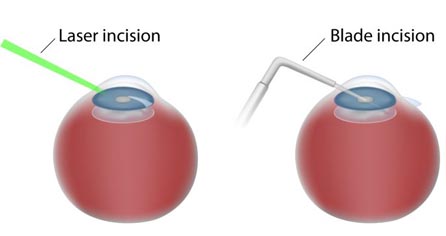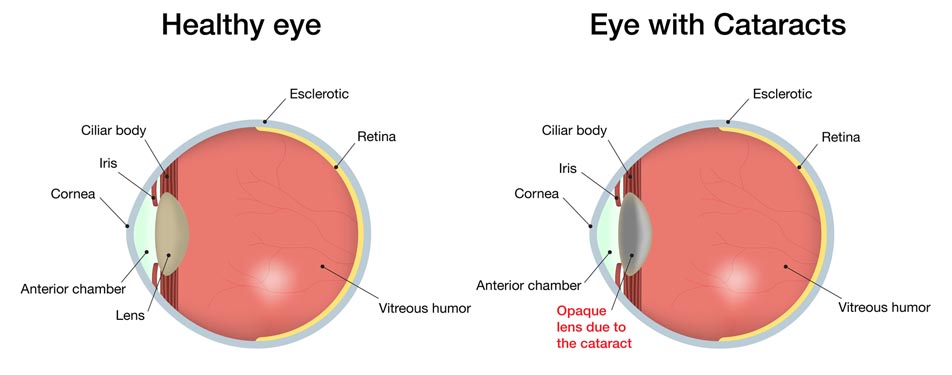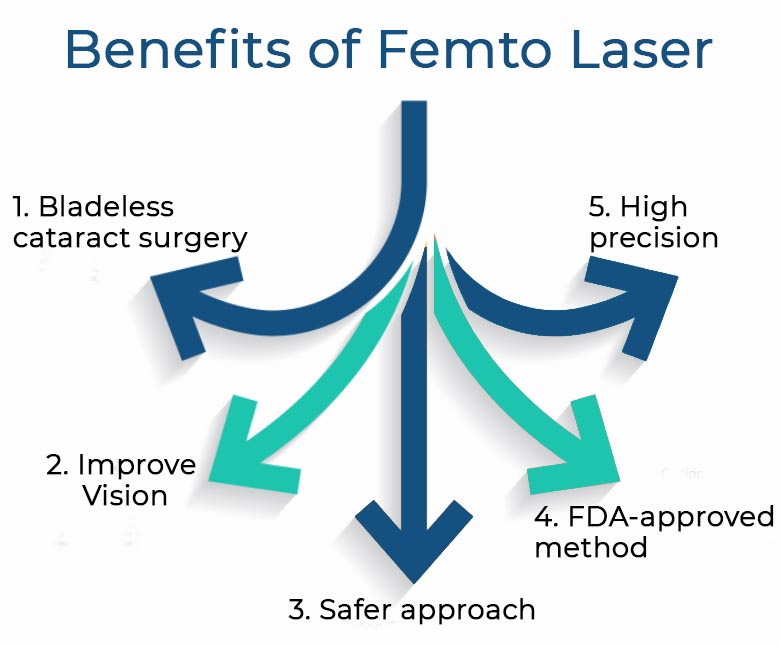Blade-Free Cataract Surgery in Phagwara, Punjab
मोतियाबिंद का इलाज
मोतियाबिंद: कारण, लक्षण, इलाज एवं ऑपरेशन का खरचा व् संपूर्ण जानकारी। Blade-Free Cataract Surgery in Phagwara, Punjab is one step forward as compared to normal cataract surgery. Traditionally, cataract surgery does not come under the category of laser eye surgery. At Mitra Eye Hospital, we provide an effective and safer treatment approach than ever before. On average, the blade-free cataract surgery cost on an average between Rs 75,000 to Rs100,000.

EYES are Priceless, Take Care of Them
The only way to end the Cataract is through surgery. No doubt, the traditional approach to do the surgery took a lot of time, it was painless and many people feared undergoing it. The deep cut to make into the eye was a different type of challenge. With the advancement in technology, many things have been improved and become safer to do. We all know, we cannot take a break from our working life for a long time and a person does not give themselves enough time to recover.
This is where healthcare services need to be short, minimal downtime, and requires less time. Fortunately, medical science has fulfilled our wish and technological advancement is like a “BOON” for us. Be it any treatment, therapy, surgery, or process we talk about it has changed, and that too for our ‘COMFORT and SAFETY.
Let me give you an insight into What is a cataract?
There are common visual impairments that make the eye lens cloudy. If the problem gets in excess, it increases the chances of blindness. Thankfully, the condition is treatable with Blade-Free Cataract Surgery.
Blade-free Cataract Surgery – No use of Blade
You must be wondering, ‘Really?’
YES!
With blade-free cataract surgery, there is no need to make incisions in the eye to treat cataracts. It uses the laser which makes the incisions and then breaks cataracts in a few minutes. So, what does this mean?
| The procedure is less painful | The procedure is completed in 35 to 40 minutes |
How is blade-free cataract surgery done?

During the painless blade-free cataract surgery, the laser beam is used to enter into the eye of the cornea and take out the cloudy lens through an artificial lens referred to as ‘Intraocular Lens’. Before beginning with the corneal incision, the oculist will perform OCT Optical coherence Tomography to map and measure the thickness of the retina.
The high-resolution cross-sectional images through OCT help the surgeon in making the precise incision. The laser beam penetrates through the incision and removes the cataract, a clouding on the natural eye lens. Intraocular lens IOL replaces the cloudy natural lens restoring the vision. Other advantages that make it more preferred include its ability to treat differently the refractive error that is unique to each eye irrespective of how identical they appear. Some characteristics vary between two eyes like anterior chamber depth, corneal curvature, and axial length.
Therefore, we need to opt for the surgical procedure that caters well to these unique features of the eyes, and Blade free Cataract surgery marks better results than traditional cataract surgery in all the ways and processes
Making the Smart Choice – To Protect the Gift of ‘VISION’
Bladeless Femto Laser Surgery:
Cataract surgery techniques have changed and that too for better results. The improved and technological advancement helps the surgeon to perform it with precision and ease. All in all, it is safe, blade-free, and the best choice.
What are the benefits of Femto Laser?

| High precision as compared to traditional approach | Laser is the new talk-of the town, which is enhancing the way surgeons perform the treatment. It provides accuracy, safety, and visual outcomes which are visible. |
| Bladeless cataract surgery | It is an edge-cutting technology which needs no knives and blades. The treatment is done with precision which makes it better as compared to when done with hand-held methods. |
| Improve Vision | Addresses the problem of cataract without affecting the cylindrical power due to abnormal corneal curvature. The correction module is used which gives better outcomes. |
| Safer approach | The safety with this procedure increases manifolds and reduces the human errors. You can say that it reduces the chances of human errors as the laser accurately controls everything. This way the chances of infection will be reduced. |
| FDA-approved method | Number of clinical trials have been done, which have made this surgery effective and safer to perform all across India. |
How is the femtosecond laser done?
With a femtosecond laser, the Patient Interface (PI) is used and contact lenses are designed. Live pictures are seen on them which makes it easier to control the way incisions are made.
LenSx Laser precision: Technological Improvement
The LenSx® Laser brings laser precision to treat the most challenging part of the eyes. This allows the surgeon to ‘FOCUS’ on every minute detail while performing the surgery. At Mitra Eye Hospital thousands of patients have benefited from our eye care treatment plan. Technological advancement will give you the confidence and avidity (zeal) to live a life you ‘DESERVE and DESIRE’. Indeed, the treatment results have excelled in the past few years.
Why Lensx?
| Completely blade-free surgery |
| Makes use of Femto laser which performs the treatment with critical steps. |
| It will correct astigmatism which is not possible with conventional phaco surgery. |
| It places accurately the laser-guided incisions which improve accuracy. |
| The results are accurate and consistent with this approach. |
| With technological advancement, this surgery helps the surgeon to perform the surgery with consistency, without any flaw, and gives precise results. All in all, this surgery is best to take utmost care of your eyes. |
Why Choose Mitra Eye Hospital?
When you put your life in someone’s hand, you should not take any decision in a hurry. Trusting the best and experienced eye specialists is of utmost importance. This is where Mitra Eye Hospital will fulfill all your eye care needs. We have the updated and top technologies to address all your eye problems.
Once you step into our hospital, you will get the best care. We also take into account the COVID-safety guidelines to make sure that you are SAFE AT ALL COSTS. Schedule your initial consultation with us and get the best care you and your family members deserve.
A cataract is a slowly progressive process of developing a cloudy layer over the natural lens of eye making, the vision of the person blurred, and causing him problems in carrying out daily activities especially, in dim light or at night like night driving. Cataracts can affect any age group right from a newborn to an old age person. Congenital cataracts can occur in the womb, at infancy in childhood due to injury, infection, malnutrition. In older people, it is a matter of age when nerves, the lens of the eye becomes weak and more prone to disorders and deformities. Secondary cataracts are an outcome of other health problems a person is suffering. It could be diabetes, too much exposure to ultraviolet lights, or side effects of medicines that a person may be taking for other ailments. Doctors diagnose the cataract in your eye through various vision tets he will make you go through. The surgical procedure of removing a cloudy layer lens from the retina and replacing it with an artificial one is the sole treatment for cataract. However, the processes of carrying out surgery vary depending on the choice made by an oculist for the same.
Phacoemulsification is a procedure of removing cataracts, making use of ultrasound tips to break or emulsify the cataract. The process begins with giving anesthesia to the area behind the eyeball, followed by making a small incision and insert fluid into the eye to prevent shock to intraocular tissues. A water stream through a small incision in the membrane that surrounds cataract free the cataract from the cortex and the ultrasound waves emulsify the cataract. The surgeon removes the cortex of the lens and leaves the posterior capsule exposed for inserting IOL. After insertion, the surgery is over.
Extracapsular cataract extraction is similar to the former process of cataract treatment. The only difference being it involves large incisions as surgical tools and instruments separate the cataract from the cortex. The rest of the procedure remains the same as in Phacoemulsification. This type of surgery is a matter of choice for patients suffering from severe eye complications and problems.
Before this technique of Phacoemulsification, the procedure of cataract surgery was Intracapsular cataract extraction. The process involves the removal of the eye lens along with the posterior capsule. It has a high-risk ratio due to large incisions it makes and the pressure it exerts on the vitreous body.
As there are variations in the methods of surgical procedures for cataract removal there, comes many options in selecting the type of Intra Ocular Lens you want in your eye. Monofocal IOL or Multifocal IOL. The former has a single focal strength for distant vision. Reading books or magazines will require the person to make use of glasses or contact lenses. In Multifocal Lens, different areas of the lens have different focusing strengths.
The Toric soft lens has different meridians of the lens that respond to power differently and correct the asymmetric power of the eye or, in other words, the problem of astigmatism. These lenses have markings on the periphery of the lens that help the eye surgeon to rotate the lens for better alignment and treatment of astigmatism.
The best IOL for your eye is the one that the surgeon recommends you as he has complete insight and understanding about the nature of the problem and healing properties of the lens. Therefore have full faith in his decisions about the type of eye surgery and ILO he selects for your eye. However, feel free to discuss with him the pros and cons of all the methods and lens types. He should be able to satisfy you with his answers and win your confidence, only then select him as your surgeon for treating cataracts.
Stellaris Microincision Cataract Surgery at Mitra Eye Hospital, Phagwara.
Eye surgeons at Mitra eye hospital facilitate the convenience of patients at the time of cataract surgery by using the Stellaris Microincision Cataract Surgery device that resolves many of the challenges that eye surgeon encounters while operating, and those if taken care of, can add wonders to the results. It ensures chamber stability throughout the procedure and permits customization according to the fluid dynamics of the individual. It reduces the incision size to 1.6-1.8 mm, which facilitates faster recovery, ensures wound sealability, and also helps in controlling astigmatism that usually occurs after surgery. It also restricts the number of post-operative precautions for the patient undergoing eye cataract surgery through the Stellaris vision enhancement system.
Cataract surgery is an outpatient surgery that takes 35-45 minutes. Many times doctors may recommend the patient to wear an eye shield for a few days after the surgery. Following Precautionary measures makes the recovery process rapid and with not many problems. Preventive measures doctors recommend most often include preventing exposure of eyes to bright light, rubbing the eyes, washing them with force. Oculist fixes the Follow-ups as per the need of the patient and may also recommend the use of eye-drops and anti-inflammatory drops to prevent itching, dryness, puffing, and irritation in eyes that exists commonly for few days after the surgery. Within eight to nine weeks, all after-effects of surgery go away, and you can enjoy sharp, clear vision. Many people may feel the need for contact lenses or glasses. Eye surgeon notifies the person about the need and when to start wearing them for better results. After cataract surgery, some incidents report that people may need second cataract surgery known as Posterior Capsule Opacification (PCO). It is a situation in which the back of the lens that was previously not withdrawn and is presently supporting the artificial lens becomes blurred and hazy. However, worry not, it is a small procedure that needs five minutes process called Yttrium-Aluminum-Garnet (YAG) laser capsulotomy. It involves making use of a laser beam to make a small opening in the clouded capsule to allow the light to pass through.


